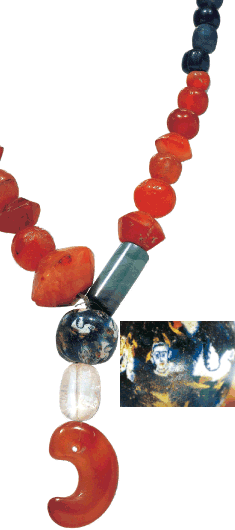
Necklace with Lapis Lazuli Inlay,
5th–6th century

Discovered in the sector of the royal tomb of King Michu in Gyeongju, this necklace (on the left) is composed of azure glass, agate, crystal beads, a jade cylinder, and an agate comma-shaped bead, with a mosaic-glass bead as the central piece. This bead has detailed motifs of human faces, white birds, and flowers on small branches. Ideas on where this bead was produced vary, though the smiles on the faces with blue eyes and converged eyebrows, and the crown, are fascinating.
5th–6th century
Discovered in the sector of the royal tomb of King Michu in Gyeongju, this necklace (on the left) is composed of azure glass, agate, crystal beads, a jade cylinder, and an agate comma-shaped bead, with a mosaic-glass bead as the central piece. This bead has detailed motifs of human faces, white birds, and flowers on small branches. Ideas on where this bead was produced vary, though the smiles on the faces with blue eyes and converged eyebrows, and the crown, are fascinating.
Horn-shaped Cup
Royal Tomb of King Michu, 5th–6th century

Horn-shaped cups appeared in East Asia around the time of change when an ancient dynasty had fallen and the next kingdom about to rise. Exchange with nomadic tribes of the Steppe occurred frequently and the custom of using Scythian horn cups was perhaps introduced then. This could be seen on the Korean Peninsula during the Three Kingdoms period (4th–7th century). Excavated examples of these vessels have been discovered primarily in the Silla capital of Gyeongju.
Royal Tomb of King Michu, 5th–6th century
Horn-shaped cups appeared in East Asia around the time of change when an ancient dynasty had fallen and the next kingdom about to rise. Exchange with nomadic tribes of the Steppe occurred frequently and the custom of using Scythian horn cups was perhaps introduced then. This could be seen on the Korean Peninsula during the Three Kingdoms period (4th–7th century). Excavated examples of these vessels have been discovered primarily in the Silla capital of Gyeongju.
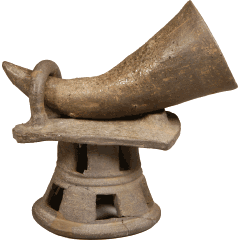
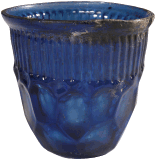
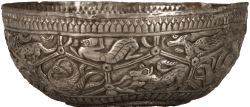
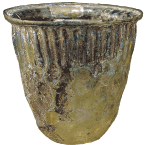
Silver Cup
Hwangnamdae Tumulus, 5th century

On the surface of this silver cup is applied a motif that often appears in decorative arts in metal from Silla. It is that of a tortoiseshell pattern, which resembles lines connecting the heavenly body, within which are arranged auspicious animals. This type of design, which corresponds to patterns found in the harnesses of East Asian nomadic tribes, was introduced to Japan during the Kofun (Tumulus) period.
On the surface of this silver cup is applied a motif that often appears in decorative arts in metal from Silla. It is that of a tortoiseshell pattern, which resembles lines connecting the heavenly body, within which are arranged auspicious animals. This type of design, which corresponds to patterns found in the harnesses of East Asian nomadic tribes, was introduced to Japan during the Kofun (Tumulus) period.
Cups with Tortoiseshell Pattern
(left) Excavated from Cheonmachong Tumulus in Gyeongju,
6th century
(right) Iran, 3rd–4th century

(left) Excavated from Cheonmachong Tumulus in Gyeongju,
6th century
(right) Iran, 3rd–4th century
Organized by MIHO MUSEUM and Kyoto Shimbun Co., Ltd.
Cooperated by Okayama Orient Museum, Ancient Orient Museum, and Gyeongju National Museum
Supported by Shiga Prefecture, Shiga Prefectural Board of Education, NHK Broadcasting Otsu Office, Biwako Broadcasting Co., Ltd.,
Embassy of South Korea in Japan, and Korean Cultural Center
Cooperated by Okayama Orient Museum, Ancient Orient Museum, and Gyeongju National Museum
Supported by Shiga Prefecture, Shiga Prefectural Board of Education, NHK Broadcasting Otsu Office, Biwako Broadcasting Co., Ltd.,
Embassy of South Korea in Japan, and Korean Cultural Center
